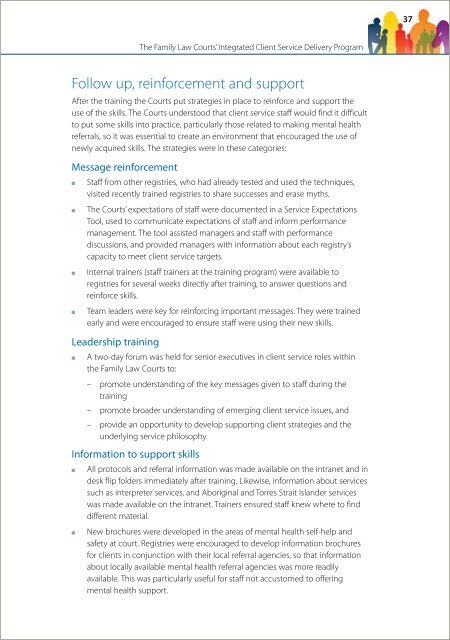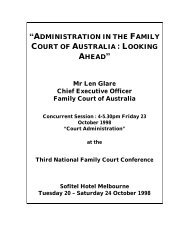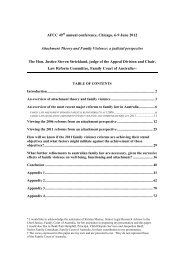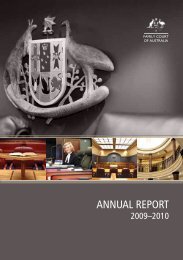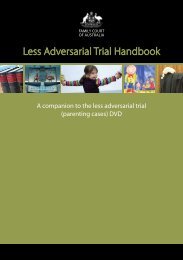Integrated client service delivery, featuring mental health support ...
Integrated client service delivery, featuring mental health support ...
Integrated client service delivery, featuring mental health support ...
You also want an ePaper? Increase the reach of your titles
YUMPU automatically turns print PDFs into web optimized ePapers that Google loves.
37The Family Law Courts’ <strong>Integrated</strong> Client Service Delivery ProgramFollow up, reinforcement and <strong>support</strong>After the training the Courts put strategies in place to reinforce and <strong>support</strong> theuse of the skills. The Courts understood that <strong>client</strong> <strong>service</strong> staff would find it difficultto put some skills into practice, particularly those related to making <strong>mental</strong> <strong>health</strong>referrals, so it was essential to create an environment that encouraged the use ofnewly acquired skills. The strategies were in these categories:Message reinforcementnnnnStaff from other registries, who had already tested and used the techniques,visited recently trained registries to share successes and erase myths.The Courts’ expectations of staff were documented in a Service ExpectationsTool, used to communicate expectations of staff and inform performancemanagement. The tool assisted managers and staff with performancediscussions, and provided managers with information about each registry’scapacity to meet <strong>client</strong> <strong>service</strong> targets.Internal trainers (staff trainers at the training program) were available toregistries for several weeks directly after training, to answer questions andreinforce skills.Team leaders were key for reinforcing important messages. They were trainedearly and were encouraged to ensure staff were using their new skills.Leadership trainingnA two-day forum was held for senior executives in <strong>client</strong> <strong>service</strong> roles withinthe Family Law Courts to:– promote understanding of the key messages given to staff during thetraining– promote broader understanding of emerging <strong>client</strong> <strong>service</strong> issues, and– provide an opportunity to develop <strong>support</strong>ing <strong>client</strong> strategies and theunderlying <strong>service</strong> philosophy.Information to <strong>support</strong> skillsnnAll protocols and referral information was made available on the intranet and indesk flip folders immediately after training. Likewise, information about <strong>service</strong>ssuch as interpreter <strong>service</strong>s, and Aboriginal and Torres Strait Islander <strong>service</strong>swas made available on the intranet. Trainers ensured staff knew where to finddifferent material.New brochures were developed in the areas of <strong>mental</strong> <strong>health</strong> self-help andsafety at court. Registries were encouraged to develop information brochuresfor <strong>client</strong>s in conjunction with their local referral agencies, so that informationabout locally available <strong>mental</strong> <strong>health</strong> referral agencies was more readilyavailable. This was particularly useful for staff not accustomed to offering<strong>mental</strong> <strong>health</strong> <strong>support</strong>.


